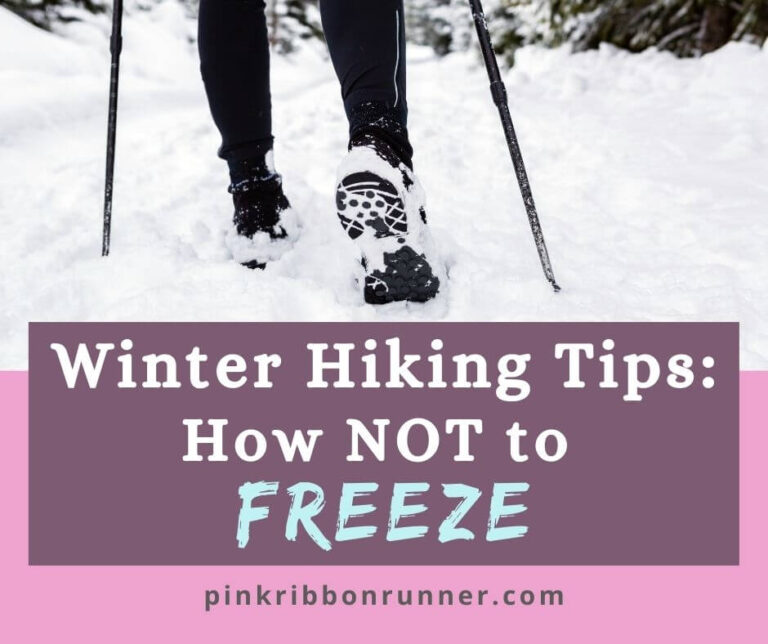How cold is too cold to run outdoors?
Running can be difficult, or even dangerous, in very cold temperatures. Muscles and joints do not function and move well in the cold. The heart has to pump harder and breathing cold air can hurt. Running in snow can be a difficult workout. And hypothermia is a risk. But running outside all year run can be a healthier option. It is a better workout, overall. But how cold is too cold to run outside?
This post contains affiliate links. As an Amazon Associate, I earn from qualifying purchases.
Alternatives to Running in the Winter Cold
My preferred cut off is about -30 degrees Celsius, but I have run even colder temperatures at -40 degrees Celsius. We don’t usually get these extreme temperatures, and when we do, they don’t last long. But it sometimes makes running indoors necessary.
I will run on an indoor track, on a treadmill or even in the pool when it is too cold. Running on the treadmill can be a great alternative. I have the Beginner’s Guide to the Treadmill for you, if you are new to treadmill running.
I will talk about pool running in an future post. Pool running can be a great workout. I have known some runners to train for marathons this way. It can also help injured runners recover and stay strong.
But if it is warmer than -30 degrees Celsius, I much prefer to run outdoors.
Our Bodies Generate Heat As We Run
Some runners might think that -30 Celsius, or even -20 Celsius, is too cold to be outdoors.
There is definitely a personal preference to when it is too cold to run outside in winter.
However, running generates body heat, so it doesn’t feel as cold as long as we keep moving.
Generally, running will feel about 10 degrees Celsius warmer than the outside ambient temperature.
But it does depend on your metabolism and how fast you run.
Running will feel about 10 degrees Celsius warmer than the ambient temperature outside.
Some People Feel Warmer; Some Cooler
Some people will actually feel warmer when running. Those are those crazy runners you see in below-zero temperatures wearing shorts and short sleeve t-shirts.
Some people will feel colder when running in the same ambient temperature.
Generally, the faster you run, the warmer you will feel. This is because your body is working harder and generating more heat.
But it also depends on how much body fat you have too. The more insulation on your body, the warmer you will feel with less effort.
Everyone determines for themselves what temperature is too cold to run in.
But I will also say that what you wear running makes a big difference in determining when it is too cold to run outdoors. Dressing for the weather can make or break a run.
What Should You Wear When Running in the Winter Cold?
What you wear outdoors in cold weather can make your winter run fabulous or make your cold weather run absolutely miserable.
Too much clothing and you will feel too hot, sweat too much and feel heavy and sluggish.
Too little and you will be cold, shivering and miserable.
Experience will tell you what to wear in different temperatures.
But what are new runners, or people like me, who forget what they wore in last year’s colder temperatures, suppose to do?
The best strategy for any runner is to dress in layers. The colder it gets, the more layers you put on. If you get too hot, you can take a layer off.
The best strategy for running in winter is to dress in layers.
Winter Running Shoes Should Have Traction
So what about your shoes? You will want something on your feet that will grip in the snow and keep your feet dry.
Trail Runners are a Good Choice for Winter Running
If you are running in snow, trail shoes are a good choice. Trail shoes, such as Saucony Peregrine or Solomon Speedcross, usually have some wind and water resistance to them if they are made from GoreTex or other similar material.
Keep in mind that water can still seep in through the lace grommets and over the top of the shoe.
If you absolutely hate getting your feet wet or if you tend to get blisters when your feet are wet, consider also wearing waterproof socks.

The biggest benefit to running in a trail shoe in winter is the deeper tread on the bottom of the shoe. The treads are designed to grip the ground on trails, and work well for snow too.
One down side of a trail shoe is that there are limited choices. They usually come as a neutral shoe. So if you need more stability, you may have to hunt for that perfect trail shoe, if it even exists. The other down fall is that you need to purchase another pair of running shoes. Well, maybe that isn’t a down side. Who doesn’t love new shoes?
Traction Cleats for Running in Snow
Added traction can be achieved with adding a traction cleat, such as YakTrax, to your road runners. These devices just slip onto the shoe and can be added to any running shoe.
Some runners love these products, but I have seen some runners become frustrated with them falling off.
However, these can be a less expensive alternative to buying a pair of trail shoes and also allow you to run in a road shoe that perfectly fits your feet.
Keep in mind that road runners are designed to keep your feet cool and usually have perforations that let the cold wind in. If you wear road runners, you might want to consider a good thick winter sock or place some duct tape inside your shoe to block the wind
Homemade traction devices are not recommended
I have also heard of some runners screwing short hexagonal screws into the bottoms of their shoes for traction. I don’t advise you try this unless you really know what you are doing. There are some guides for this floating around the internet. But the screws can poke into your feet and they can fall out.
What to Wear on Your Face when Winter Running?
When running in the cold, protect your face. Cold, dry air can be irritating to your airways. The cold always takes my breath away when I first start out, until I get warmed.
A fabric neck tube, such as a Buff, over your mouth and nose can help protect your airways.
I find it hard to breathe deeply with fabric over my mouth and nose, so I bought a special winter one with holes over my mouth and nose. It helps, but I still find it hard to breathe when I am working hard. Once I warm up, I usually just pull it away from my face.
In colder temperatures, a thin layer of petroleum jelly or Body Glide on exposed skin can help protect it from the damaging cold.

I enjoy running outdoors, and winter running outside has allowed me to witness some pretty spectacular scenery. A warm shower and a hot tea afterwards does wonders to warm me up after a great run in the cold. For more great tips on winter running, read How to Run in the Snow.









I am laughing as I read. I complained this am running in the 48 degree F weather with pants, hoodie, gloves, and ski cap. I’m not a good runner in the cold. But, I did it.
I always try to bring gloves when running in cold weather and I choose running clothes that are still breathable when I feel already warm inside yet still very cold outside and it’s funny how I can still sweat inside. A neck gater also helps me to keep my neck and nose covered while I run.
Never too cold to run. I head out everyday, no matter what the temperature is. You have to plan your route properly so you not running into the wind especially at the start and less wind on your back on the way back so you don’t cool down too much on the backside. Many run end with my outer layer freezing to the second layer because the cold freezes the moisture you build up.
A warm shower at the end is always the best.
Great advice. Thank you for your comment.